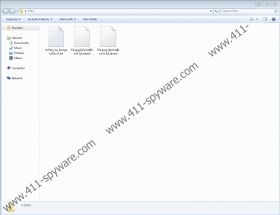Divine Ransomware Removal Guide
Divine Ransomware is a malicious computer infection that can virtually block you from accessing your data. This is a very sneaky program because it encrypts your files and then deletes itself. It means that there is nothing left to remove, but you have to deal with the encrypted files. What’s more, there’s usually no way to restore those files because the infection rarely issues the decryption key. So what do you do? You should not be averse to the idea of starting from scratch. Or, if you have copies of your files saved on another computer or hard disk, you can transfer them back to your system.
The best way to fight a ransomware infection (and we’re sure we’ve mentioned this before) is to avoid it in the first place. And anyone can avoid a ransomware infection if they know how it spreads. We do know that Divine Ransomware is another version of the Everbe 2.0 Ransomware infection, so we can assume that this program employs the same distribution methods as its predecessor. Our research suggests that these programs usually spread via spam messages and corrupted RDP (Remote Desktop Protocol) connections. In other words, users “invite” these programs into their systems unwittingly.
As far as spam emails are concerned, they are easier to spot and avoid. While most of the spam mail gets filtered into the Junk folder, we might still get some messages into the main inbox, too. This happens because spam email can be quite sophisticated. Do not be surprised to find it masquerading as notifications from legal entities. For instance, a spam email might look like an online shopping invoice or like some report from a financial institution.
The point is that you have to be attentive and alert. Did you really order something from that store? Do you really have an account in that bank? Have you really been expecting this email? There is a list of questions you can go through before downloading the attached file. Finally, as the last resort, you can scan the downloaded file with a security program. If the program deems the file to be safe, you can open it.
When it comes to RDP connections, you might receive an automated message from someone you supposedly know, but if that person was infected with ransomware, their system might become part of the malware distribution network. Therefore, just like with the spam messages, you shouldn’t be so eager to open every single file and click every single link you receive via RDP.
When users fail to practice safe web browsing habits, they get infected with the likes of Divine Ransomware, and then their files get encrypted. As mentioned, this infection deletes itself once the encryption is complete. It does not encrypt system files, so you can still operate your computer, but the infection expects you to contact its developers via the given email so that you would transfer the ransom fee.
We have grounds to believe that the people behind Divine Ransomware would not issue the decryption key even if you were to pay the full price. Hence, do yourself a favor and ignore the ransom note. If you have copies of your files saved on an external hard drive, delete the encrypted copies and then transfer the healthy files back into your system.
Do not forget to safeguard your computer with a security tool that would protect you from similar intruders. However, your own behavior online is just as important in securing your system.
How to Remove Divine Ransomware
- Remove the most recent files from Desktop.
- Open the Downloads folder.
- Delete the most recently downloaded files.
- Run a full system scan with SpyHunter.
Divine Ransomware Screenshots:



